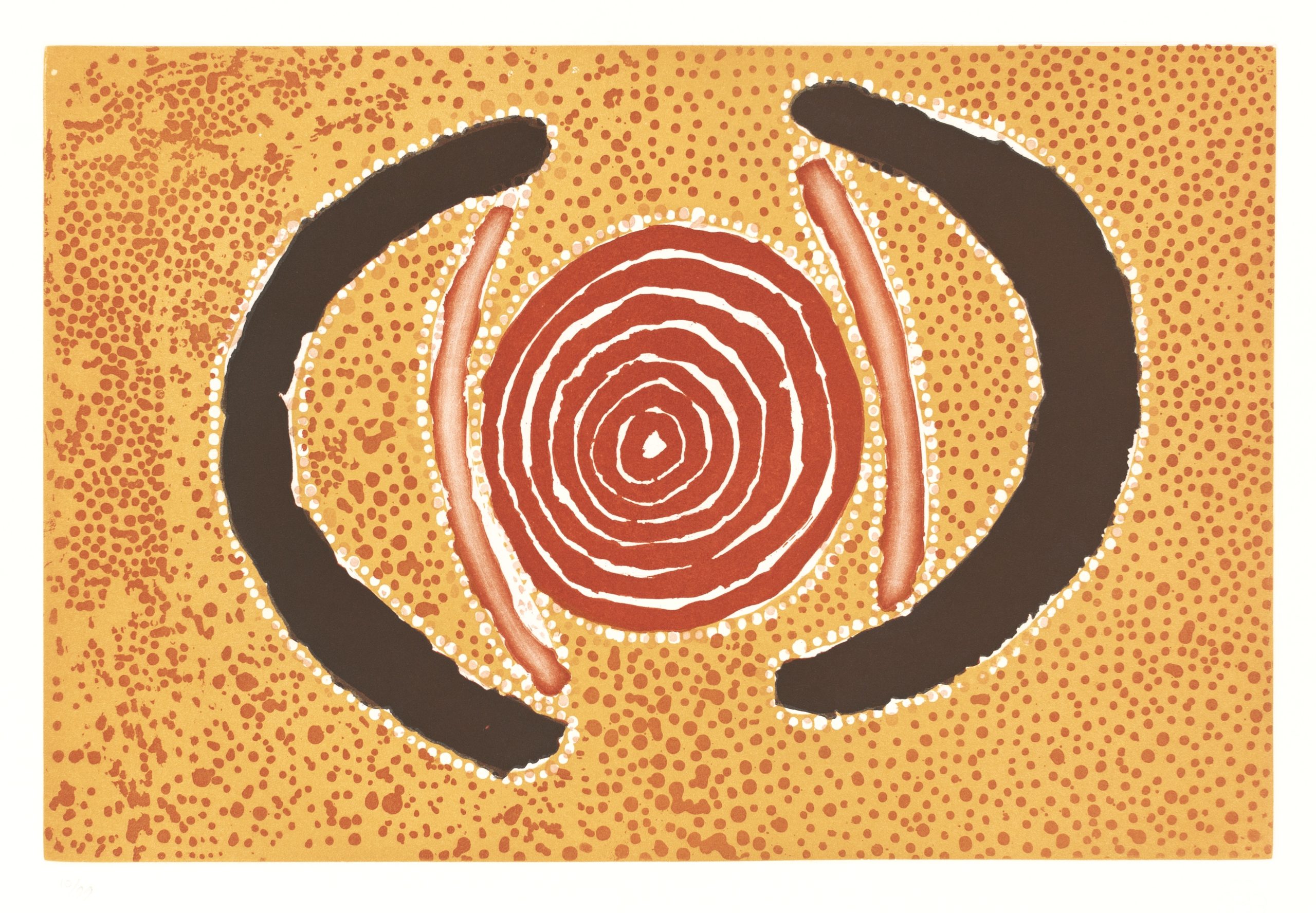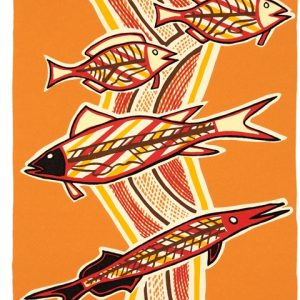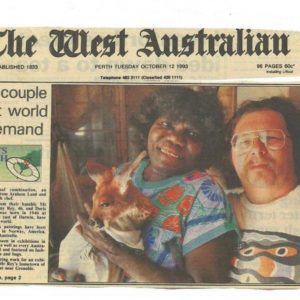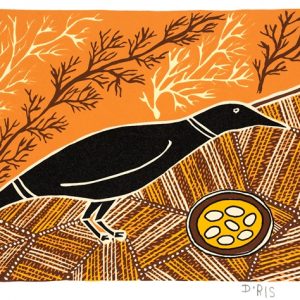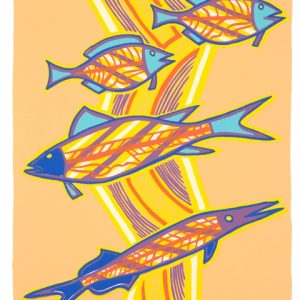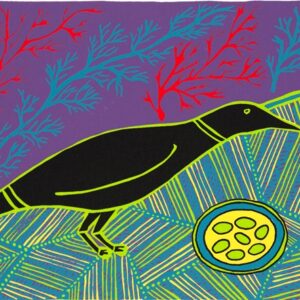Description
Artwork Details
- Etching Sugar lift painting aquatint on two plates
- Edition: 99
- Editioned: January 2003
- Size: 325 mm x 490 mm (image), 560 mm x 760 mm (paper)
- Paper: Magnani Pescia 300gsm
- Printer & Studio: Basil Hall, Basil Hall Editions Darwin NT,
Ngarlu is country belonging to the Anmatjerre language group south-east of Yuendumu. Ngarlu literally means red rock. The Jukurrpa of this place tells of a Jungarrayi man, named Lilipinti travelling west to another country for Kuridji, men’s ceremonial business. Jungarrayi, Japaljarri, Jupurrula and Jampijinpa men were travelling east to Kurpurrulu On his travels he saw a Napngardi woman, who is his mother-in-law according to the Aboriginal skin system and forbidden to him. Lintyipilinti watched the woman from where he sat whilst she was urinating. He was so impressed with what he saw that he decided to woo her. His imprint has been left in the rocks, which reminds the people of his thinking. Whilst he was sitting at Yumurruluwanu he spun some Wirriji (hair string) and sung a love song. Jungarrayi was wearing jinjila (ceremonial adornment) around his arms and neck to look attractive to her. He had weapons and a ngami (water carrier). Lilipintifi fell in love with her however, and when he arrived back home to Ngarlu he couldn’t stop thinking about her. A Jurlpu (bird) carried these loves songs over to the Napangardi. The Jurlpu flew back with the Napangardi on his wings, to join with the Jungarrayi at Ngarlu. The women of Ngarlu gossiped about this wrong-skin love union. These women turned into Miinypa, native fuschia flowers, which are prevalent at Ngarlu today. When Lilipinti and his Napangardi made love, his penis broke off in side of her and they both turned to stone. There is a rockhole at Ngarlu which shows the place of their love-making. They are seen in the rocks at Ngarlu, a long water hole with a broken boulder reminds the people of this union. Wapunungku, a big tree was crying, that tree is still there today. The kirda (owners) for this Jukurrpa are Japaljarri and Jungarrayi men and Napaljarri and Nungarrayi women.
About Yilpinji – Love Magic – Prints
These limited edition prints by Old Masters from Wirrimanu (Balgo Hills) in Western Australia, Yuendumu and Lajamanu in the Northern Territory, have come about as the result of a unique cross-cultural collaboration. It has involved Aboriginal artists, remote art center staff and community organizations, a fine art print publishing house, a number of anthropologists who have specialised knowledge of these cultural groups, and two highly respected non-Indigenous printmakers.
The Kukatja and the Warlpiri people have powerful traditions of love magic rituals and ceremonies, involving the singing of secret love songs as well as other forms of artistic expression. Sometimes this involves the painting of special designs onto their bodies or the production of ‘love objects’ to enact these ceremonies. Called ‘Yilpinji’ in the Warlpiri language, these ceremonies are enacted separately by men and women as a means of attracting the object of their sometimes adulterous or otherwise forbidden desire. In addition, many Dreaming narratives and associated ceremonies belonging to the Kukatja and Warlpiri peoples make powerful statements about the consequences of illicit, illegal love – love that is, that offends the strict riles of their kinship structures. For example, amongst Warlpiri and Kukatja people the ‘love that dare not speak its name’ may well be the love (or lust) of a son-in-law for his mother-in-law, or vice versa.
Paintings of Yilpinji not only relate to moral and ethical behaviour and the transgressions that sometimes occur but, like other Dreaming narratives, they are attached to specific tracts of land. The often lengthy narratives associated with the Yilpinji paintings provide guidance about how (ideally) people should interrelate with one’s fellow human beings as well as providing templates for their interactions with other species and with the natural world. Dreaming narratives relating to Love Magic ceremonies and themes have a range of manifestations and iterations, and can be expressed through a variety of art forms.
Dreaming narratives are deemed to be owned (a form of orally transmitted copyright) by certain individuals and groups (communal ownership) within indigenous kinship systems. Usually only certain parts of Dreaming narratives are made publicly available to outsiders or children. The paintings act as mnemonic devices for the longer narratives associated with them. Dreaming narratives closely relate to specific tracts of land and environmental features. At the same time they deal with the ‘big’ or important philosophical, spiritual, moral and ethical subjects. These include life, death, betrayal, dishonesty in relationships, love, hate, lust, incest and other extreme emotions and practices. Sexuality, family relationships, relationships between humans and other species are included as well as relationships between human beings and the environments, youth, aging, physical and psychological survival, birth, death, how to raise children, compassion, generosity, meanness and the like. Many of these Dreaming narratives and their accompanying visual manifestations have a Yilpinji (poorly translated as ‘love magic’) component, providing advice on how not to act, as well as indicating desirable behavior.
In addition, Love Magic charms, spells and songs relate to the many different Dreaming narratives on which the prints in this exhibition are founded. The works here include stories about objects which ‘hold’ love magic, relay information about powerful love ‘singers’ (some good, some evil), as well as relating tales about long term faithfulness in love relationships and the virtures of nurturing and respecting the object of one’s love and desire. This includes the terrible consequences of uncontrolled sexual passion. The paintings, prints and other visual imagery relating to this subject matter can be understood as concentrated, abbreviated versions of these much longer oral narratives.
The folio of prints by these accomplished and knowledgeable artists, men and women of ‘high degree’, explore such themes through the powerful medium of the visual arts.

